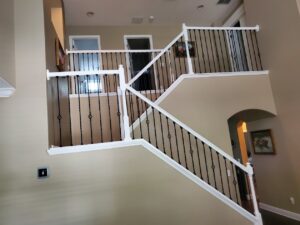
Staircase design tips are essential when creating a staircase that is more than just a way to get from one floor to another—it’s a statement of style, craftsmanship, and functionality. A thoughtfully designed staircase not only enhances your home’s visual appeal but also adds long-term value and functionality.
At CFL Custom Carpentry, we’ve built countless custom staircases that blend beauty with practicality. Whether you’re remodeling a historic home or adding modern flair to a new build, these 7 essential staircase design tips will guide you in crafting a staircase that’s both stunning and safe.
1️⃣ Staircase Design Tips for Safety and Compliance
The first rule of staircase design is safety. Your staircase must meet local building codes for tread height, riser depth, handrail height, and spacing between balusters. According to The Home Depot, a typical rise is 7–7.75 inches, with a run of 10–11 inches.
Adequate lighting, non-slip surfaces, and sturdy handrails are non-negotiable. A safe staircase is the foundation of great design.
2️⃣ Choosing Materials: Staircase Design Tips for Long-Lasting Style
The materials you choose influence both the durability and aesthetic of your staircase. Hardwoods like oak, maple, and walnut are classic choices for treads and railings, while metals like wrought iron or stainless steel offer a modern touch.
For inspiration on mixing materials, explore Houzz’s staircase design ideas. At CFL Custom Carpentry, we often blend materials to create unique designs that complement the client’s home and lifestyle.
3️⃣ Exploring Styles: Staircase Design Tips for Every Home
Your staircase should complement your home’s architecture and design vision. Here are a few popular styles to consider:
-
Straight Staircases: Clean and simple for modern or minimal homes.
-
L-Shaped and U-Shaped: Ideal for tighter spaces or more dynamic layouts.
-
Spiral and Helical: Compact, sculptural, and visually striking.
-
Floating Stairs: Open and airy, perfect for a sleek, modern vibe.
Check out The Spruce’s guide on staircase types for a deep dive into these styles.
4️⃣ Adding Details: Staircase Design Tips for a Custom Look
The little things make a big difference in staircase design:
-
Balusters and Newel Posts: From traditional turned wood to contemporary steel.
-
Treads and Risers: Contrasting colors or materials add depth.
-
Under-Stair Storage: Turn unused space into functional solutions.
-
Lighting: Integrated lights create ambience and safety.
For visual inspiration, explore Pinterest’s staircase ideas board.
Your staircase should flow with your home’s layout and needs. Consider:
-
Placement for accessibility and visual flow.
-
Width (minimum 36”, ideally wider for comfort).
-
Landings for safety and visual breaks.
-
Noise reduction with materials like carpet or acoustic underlays.
At CFL Custom Carpentry, we help clients make choices that combine beauty and practicality—so your staircase works as well as it looks.
6️⃣ Why Professional Help Matters: Staircase Design Tips from the Experts
Designing and building a staircase requires precision. A professional carpenter ensures:
-
Proper structural support.
-
Compliance with codes.
-
Seamless design integration.
-
Flawless finishes.
Our team at CFL Custom Carpentry guides you from concept to completion, ensuring your staircase is built to last.
7️⃣ Final Thoughts: Staircase Design Tips for a Timeless Investment
A staircase is more than just a set of steps—it’s a design opportunity that transforms your home. By following these staircase design tips, you’ll create a staircase that is functional, safe, and a true work of art.
For more ideas, explore:
Ready to bring your staircase vision to life? Contact CFL Custom Carpentry for expert craftsmanship and personalized design that elevates your home.